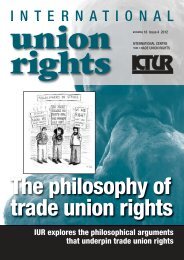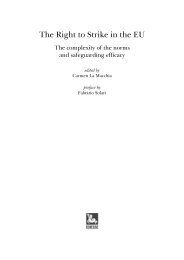Global Framework Agreements - International Centre for Trade ...
Global Framework Agreements - International Centre for Trade ...
Global Framework Agreements - International Centre for Trade ...
Create successful ePaper yourself
Turn your PDF publications into a flip-book with our unique Google optimized e-Paper software.
than she would on the U.S. side. The price of thatgallon of milk used to be fixed and subsidised,along with tortillas, bus fare and other basicnecessities. Previous waves of economic re<strong>for</strong>msdecontrolled prices and ended consumer subsidies,as Mexico was pressured to create morefavorable conditions <strong>for</strong> private investment.And investors have done very well. In one ofthe recent diplomatic cables published byWikileaks, the U.S. government admits “The netwealth of the 10 richest people in Mexico -- acountry where more than 40 percent of the populationlives in poverty -- represents roughly 10percent of the country’s gross domestic product.”Carlos Slim became the world’s richest man whena previous PRI President, Carlos Salinas deGortari, privatised the national telephone companyand sold it to him. Ricardo Salinas Pliego, whoowns TV Azteca, is now worth $8 billion andEmilio Azcárraga Jean, who owns Televisa, isworth $2.3 billion. Both helped current MexicanPresident Feiipe Calderon get elected in 2006.German Larrea and his company Grupo Mexicogot the concessions to operate some of theworld’s largest copper mines. Grupo Mexico wasaccused of industrial homicide by miners’ unionpresident Gomez Urrutia after 65 people (manyof them contract workers) died in an explosion inFebruary 2006. Since June 2007 the GrupoMexico copper mine in Cananea has been onstrike. Last year Larrea and the Mexican governmentcooperated in using armed <strong>for</strong>ce to open itsgates and bring in strikebreakers.In reality, much of the PRI’s labour law re<strong>for</strong>mis already the reality on the ground in Cananea,at other mines, or among maquiladora workersnear the U.S. Mexico border. For years the rightsof workers in northern Mexico, and even the ruleof law itself, have been undermined by the growingpower of corporations.Corporatism and nationalismThe corporate trans<strong>for</strong>mation of the Mexicaneconomy began long ago, moving the countryaway from nationalist ideas about developmentwhich were dominant from the end of theMexican Revolution through the 1970s.Nationalists advocated an economic system inwhich oil fields, copper mines, railroads, the telephonesystem, great tracts of land, and other keyeconomic resources would be controlled byMexicans and used <strong>for</strong> their benefit.Under President Lazaro Cardenas in the late1930s, Mexico established a corporatist system inwhich one political party, the PRI, controlled themain sectors of Mexican society - workers, farmers,the military and the “popular” sector. PRIgovernments administered a network of socialservices, providing healthcare and housing, atleast <strong>for</strong> people in those organised sectors.Cardenas also nationalised Mexico’s most importantresource - oil - in a popular campaign.National ownership of oil, and later electricalgeneration, was written into the Constitution.Land redistribution and nationalisation had apolitical as well as economic purpose - the creationof a section of workers and farmers whowould defend the government and its politicalparty, into which their unions and producerorganisations were incorporated.After World War Two, Mexico officially adopteda policy of industrialisation through importsubstitution. Factories produced products <strong>for</strong> thedomestic market, while imports of those productswere restricted. The purpose was to develop anational industrial base, provide jobs, andincrease the domestic market. Large state-ownedenterprises eventually employed hundreds ofthousands of Mexican industrial workers in mines,mills, transportation and other strategic industries.Unions had their greatest strength in the publicsector. Foreign investment was limited.Enrique Davila, professor at San Diego CityCollege, calls the system “nationalism in rhetoric,selling out the country in practice.” Under successivePRI administrations a vast gulf widenedbetween the political and economic elite, whomanaged the state’s assets and controlled governmentpolicy in their own interest, and workersand farmers, especially those not in the <strong>for</strong>malsector. To protect this elite, the country’spolitical system became increasingly repressive.In the 1970s, to finance growth while the priceof oil was high, Mexico opened up its financial systemto <strong>for</strong>eign capital (mostly from the U.S.), andthe country’s <strong>for</strong>eign debt soared. Managers ofstate enterprises like the oil company ran privatebusinesses on the side, along with politically connectedunion officials. Rackets and corruption proliferatedwhile labour and campesino leaders whochallenged the system were imprisoned or worse.The debt and the hold it gave to <strong>for</strong>eign financialinterests spelled the end of nationalist development.Oil prices fell, the U.S. Treasury jackedup interest rates and in 1982 the system collapsedwhen Mexico could no longer make debt payments.The government devalued the peso inwhat is still infamous as the great “peso shock.”In the Constitution Mexicans still had the rightto housing, healthcare, employment and education,but millions of people went hungry, had nohomes, were sick and unemployed and couldn’tread. The anger and cynicism felt by manyMexicans toward their political system is in greatpart a product of the contradiction between theconstitutional promises of the revolution a centuryago, plus the nationalist rhetoric that followed,and the reality of life <strong>for</strong> most people.In a desperate attempt to generate jobs and revenue<strong>for</strong> debt payments, the government encouragedthe growth of maquiladoras, the <strong>for</strong>eignownedfactories on the northern border. By 2005over 3000 border plants employed over two millionworkers making products <strong>for</strong> shoppers fromLos Angeles to New York. In 1992 they alreadyaccounted <strong>for</strong> over half of Mexican exports, andin the NAFTA era, became the main sector of theeconomy producing employment growth.Maquiladora development undermined thelegal rights of workers in the border area, andany laws viewed as discouraging investment. Thegovernment had a growing interest in keepingwages low as an attraction to <strong>for</strong>eign investment,instead of high enough that people could buywhat they were making. The old official unions,including the Confederation of Mexican Workers(CTM) controlled restive workers, rather thanorganising them to win better conditions.One of the most important methods of control isthe protection contract. Cooperative unions signagreements with factory owners, who pay it “dues”<strong>for</strong> workers who often have no idea that the unionand contract even exist. They find out quickly,however, when they try to organise any independentef<strong>for</strong>t to raise wages or improve conditions.The company and official union claim a contractalready exists. If workers try to protest, they’reLabour historyin Mexico <strong>for</strong>decades hasbeen dominatedby valiant battlesfought by workersto organiseindependentunions and ridthemselves ofprotectioncontractsPage 21 Volume 18 Issue 2 2011INTERNATIONAL union rights





